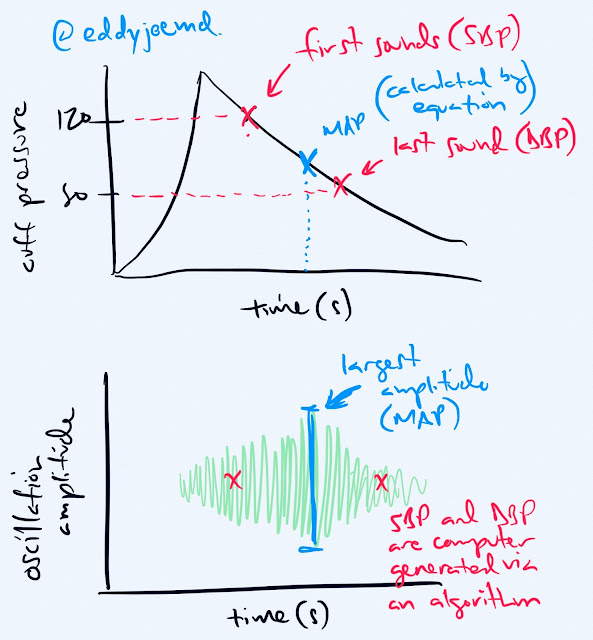
Link to Abstract
Link to Article
Full disclosure. I did not learn this until I was a fellow in Critical Care Medicine. It is not widely taught. Do not feel bad that you did not know this. All I ask is for your help to share this with others so we all speak the same language and do the best for our patients.
What are the normal sounds you hear with the "old fashioned"/auscultatory method of taking a patients blood pressure?
Those sounds define the systolic blood pressure and diastolic blood pressure respectively.
Then you do math and could calculate the mean arterial pressure (MAP) by using the formula of (2xDBP)+SBP/3 but there are a number of different ways to derive the MAP.
Does the BP cuff you have in the ICU, hospital or throughout the majority of doctor offices have ears? We if that's the case, you CANNOT assume that the SBP and DBP provided by these devices are exact.
How do oscillometric devices work?
The device measures the oscillations from the blood vessel wall during cuff deflation. The maximal oscillation point is the MAP. The device uses an algorithm that is proprietary to define the SBP and DBP. Those algorithms are closely kept secrets to the manufacturers.
Why is this important, well, BP is GOLD in the ICU world. My nurses titrate pressors based on MAP number, as the guidelines suggest, but I have too often seen nurses whipping out their phone calculating the MAP by hand as they feel that the numbers generated on the screen are inaccurate. Now, this occurred when I trained in community academic hospital, then ivory tower fancy pants hospital, and now in a community hospital which is why I feel writing this post is so important. We need to understand how our technology works!
It is known, however, that the MAP is the most important value generated by the device.
The study listed above noted that there was a significant difference between calculated MAP, i.e. the nurses/staff doing the calculation themselves, and the observed MAP (generated by the machine). They found that the generated MAP could either be lower or higher that the observed MAP. These differences were amplified even further when analyzed on individual patients rather than the cohorts. Would you feel comfortable treating your patients like this? I sure don't.
The authors discuss a trial where patients had their BP taken via oscillometric device in the OR vs. intraarterial and there was no statistically significant difference in the MAP. There was a difference in the SBP by 19mmHg, though. Could you imagine treating these patients based on an algorithm generated SBP? You'd be treating them (or not treating them) inappropriately!
Now, this post may seem like it's being directed at nurses, after all, you all are the main ones at the bedside, but we all need to get better. The docs needs to stop presenting patients to each other by referencing the SBP. Docs need to stop telling nurses to hit SBP goals for their pressors instead of MAPs.
Well, now you know how this all works and you won't make silly comments anymore. I hope I taught you something.
- EJ



No comments:
Post a Comment